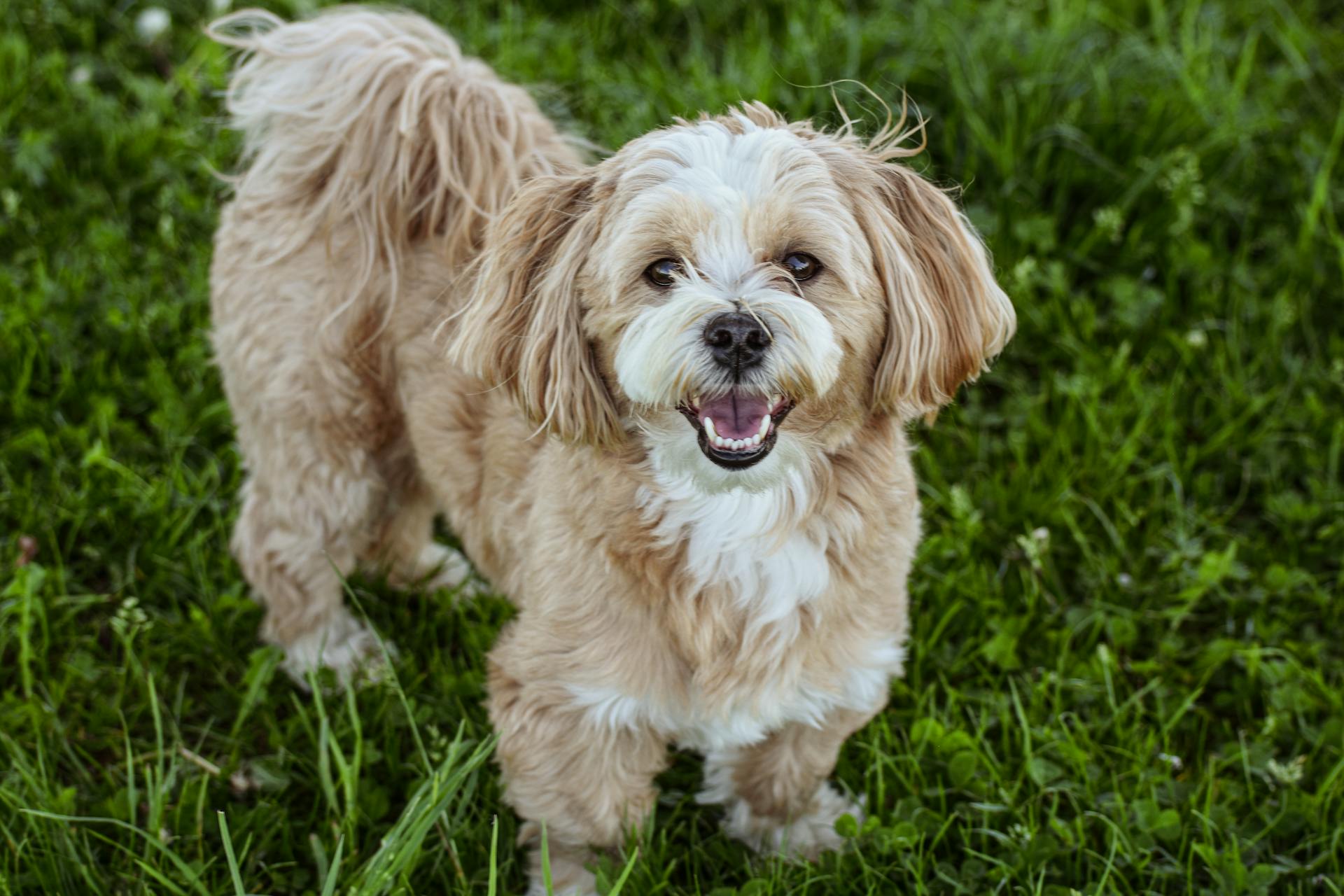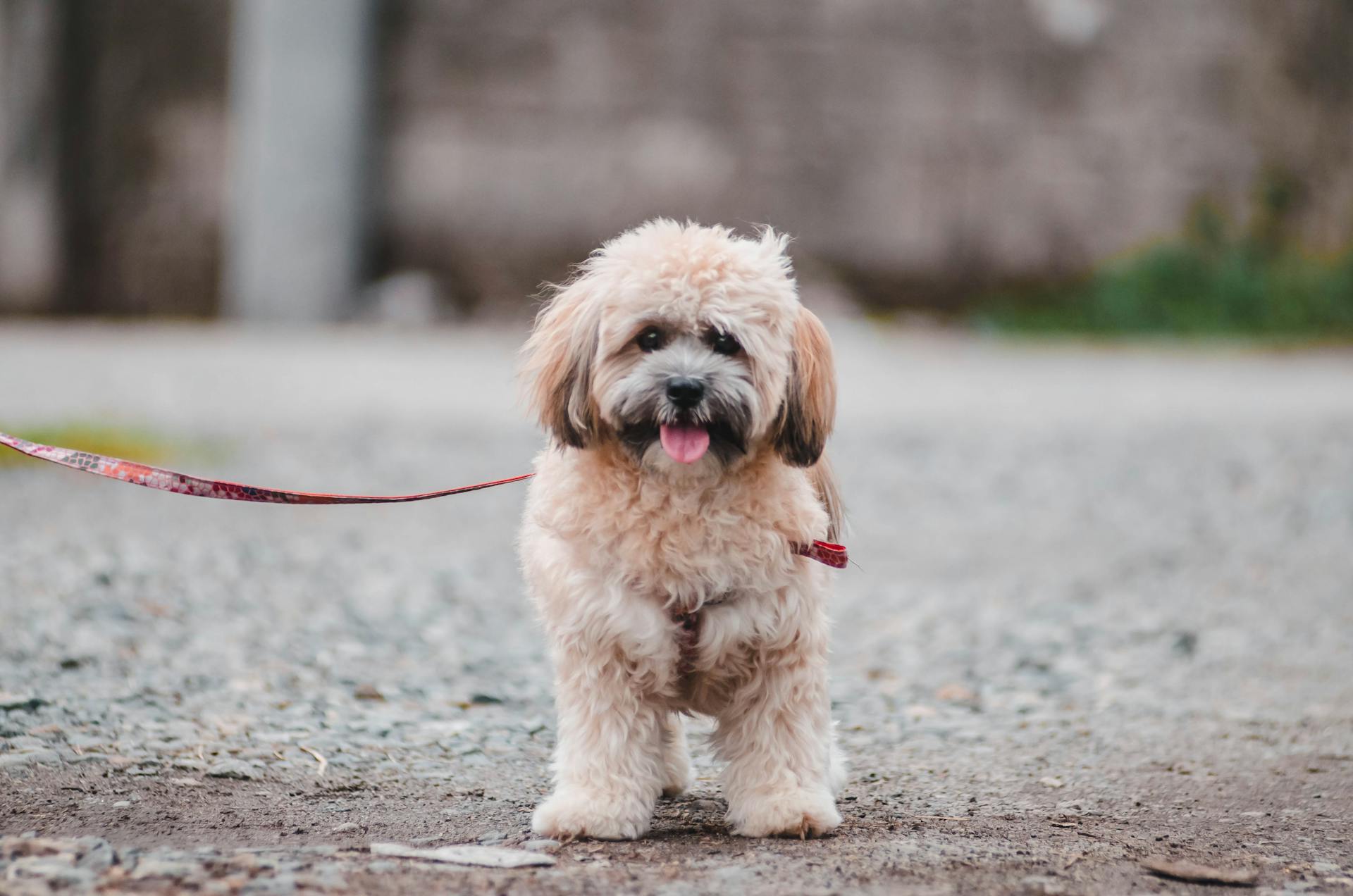
The Lhasa Apso breed has its roots in Tibet, where it was highly valued as a loyal companion animal. Originating in the 13th century, the Lhasa Apso was bred to be a watchdog and companion for the royal family.
The name "Lhasa Apso" literally translates to "long-haired Lhasa dog" in the Tibetan language. This name refers to the breed's distinctive long, flowing coat.
Lhasa Apsos are known for their small to medium size, typically weighing between 13 and 18 pounds. They have a sturdy build and a long, dense coat that requires regular grooming.
You might like: Lhasa Apso with Long Hair
Origin and History
The Lhasa Apso name is steeped in history and culture, with roots dating back at least 8000 BCE.
In Tibet, small, shaggy dogs were known as early as 8000 BCE and were often presented as gifts to visiting dignitaries and as tokens of good luck.
These little dogs were believed to bring peace and prosperity to homes in which they lived, and as they spread around the world, they became increasingly popular.
The Lhasas were bred to resemble the lion, a symbol of Tibetan royalty and the power of Buddha, and they became fixtures inside the homes of Tibetan nobility and in lamas' monasteries.
They were used as sentinels to alert their owners to a stranger's approach, and their sharp bark and fine hearing made them well-suited for this role.
The Lhasa Apso breed was brought to the West around the turn of the century by British explorers, emissaries, and other travelers to Tibet, who referred to them as "Lhasa Terriers."
It wasn't until later that authorities distinguished between the leggier and longer-headed Tibetan Terrier and the smaller Lhasa Apso.
The Lhasa Apso gained a firm foothold in the United States in the 1930s and has been popular ever since.
The breed was first introduced to the United States in 1933, when the 13th Dalai Lama gave a pair of Lhasas as a gift to C. Suydam Cutting.
The American Kennel Club officially accepted the breed in 1935 in the Terrier Group, and later transferred it to the Non-Sporting Group in 1959.
A fresh viewpoint: English Bull Terrier Dog Names
Breed Overview
The Lhasa Apso is a breed that comes in a variety of colors, including silver, liver, black, tan & black, gray, charcoal, cream, golden, white, blue, grizzle, red gold, and red.
They're a great fit for families, singles, and those living in smaller spaces due to their adaptable nature.
These dogs are known for being confident, alert, affectionate, and intelligent, making them a joy to be around.
Consider reading: Lhasa Apso Black and White
One of Three Tibetan Breeds
The Lhasa Apso is one of three Tibetan breeds in the Non-Sporting Group.
These three breeds hail from Tibet, a region known for its rich canine heritage.
The Lhasa Apso isn't the only breed from this region, though its name doesn't give away its origins as easily as the other two.
The Tibetan Terrier and Tibetan Spaniel also call Tibet home, making them a trio of Tibetan breeds.
Recommended read: Lhasa Apso in Tibet
Breed Overview
The Lhasa Apso is a breed that has been around for quite a while, and is one of the parent breeds of the Shih Tzu.

They're a popular breed, so you may want to check your local shelter or a rescue organization before heading to a breeder.
Lhasa Apsos are known for their long coats, which make them a sight to behold.
They're suitable for families, those living in smaller spaces, and singles.
These dogs are confident, alert, and affectionate, making them a great addition to many households.
One important thing to note is that Lhasa Apsos can be quite vocal, so expect plenty of barking.
They're intelligent and can be trained, but it's essential to start training them right away to minimize barking.
Good Family Dogs?
If you're thinking of getting a Lhasa Apso for your family, they can make fantastic pets, but it's essential to do some work upfront, especially if you have kids.
They have a "large and in charge" attitude, which can lead to issues if not properly managed. This means they may take on a dominant role when playing with children.

By starting socialization with your pup as soon as you bring them home, you can help negate their need to be in charge, making them get along better with kids.
You'll also want to train your dog not to nip or growl at kids who are on the rowdy side, and ensure children understand how to respect the dog's boundaries.
Once your pup is properly trained, you can expect to have a fun-loving and adventurous dog who gets along with all family members.
Personality and Characteristics
The Lhasa Apso is a spirited and highly regarded companion, believing they are the special one in the household. They're friendly and assertive, able to distinguish friend from foe and letting those they love know when they're bothered.
Their confidence is unmatched, with a unique ability to think they're much larger and tougher than they actually are. This confidence can sometimes make them independent and challenging to train.
In terms of size, Lhasas stand about 25 cm (9.8 in) tall, with bitches slightly shorter. Their coat is thick and heavy, with a hard straight outer coat and a medium under-coat, coming in a variety of colors including black, red, and white.
Temperament & Intelligence
The Lhasa Apso's temperament is a unique blend of confidence and independence. They're not afraid to speak their mind and assert themselves, even if they're small in size.
This breed has a strong sense of self-importance, believing they're much larger and tougher than they actually are. In Tibet, they're even called "abso seng kye" or "bark lion sentinel dog", a name that reflects their fearless attitude.
Socialization from an early age is crucial to help a Lhasa Apso learn to get along with everyone, as they can be territorial with other dogs and pets. They're also not always tolerant of children who are too rough around them.
Despite their independent nature, Lhasas are intensely devoted and loyal to their people. They're always up for affection and playtime, but on their own terms.
Their high intelligence means they can be a challenge to train, but it's also what makes them such excellent companions. They're the family comedians, always ready to bring a smile to your face.
A different take: Dog Names That Are Not Common
Characteristics

The Lhasa Apso is a small dog, standing about 25 cm (9.8 in) at the withers.
They come in a variety of coat colors including black, red, dark grizzle, golden, honey, parti-colour, sandy, slate-coloured, smoke-coloured, and white.
Their coat is thick and heavy, with a hard straight outer coat and a medium under-coat.
The Lhasa Apso's eyes are dark and their nose is black.
Their ears are pendant, and their tail is curved, sometimes with a kink at the tip, and should be carried over the back.
This breed ranks 68th in Stanley Coren's The Intelligence of Dogs, indicating fair working-obedience intelligence.
Many Lhasa Apsos live into their early 20s in good health.
You might like: Black Lhasa Apso
Frequently Asked Questions
What should I name my Lhasa Apso?
Consider names that reflect your Lhasa Apso's personality, such as Hazel for a gentle soul or Miikka for a playful and spirited companion. Choose a name that resonates with your dog's unique characteristics and heritage.
What is the other name for the Lhasa Apso?
The Lhasa Apso is also known as Abso Seng Kye, which translates to "Bark Lion Sentinel Dog". This name reflects the breed's original purpose as an alerting and guarding dog in Tibetan culture.
What are some unique dog names?
Consider unique dog names like Aintzane, Alucard, or Dweezil for a pet that stands out from the crowd. These unconventional names offer a fresh take on traditional pet nomenclature
Featured Images: pexels.com
